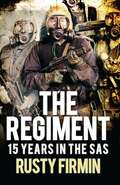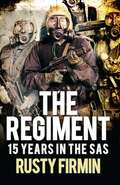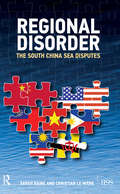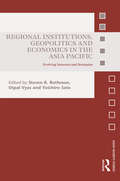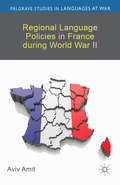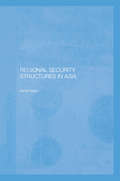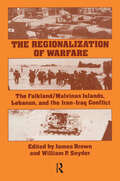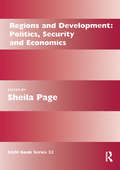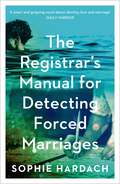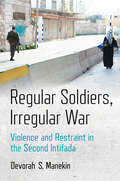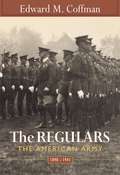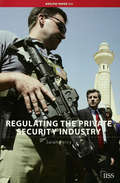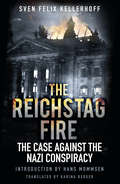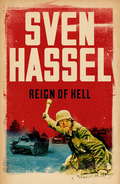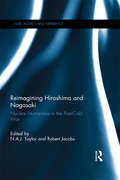- Table View
- List View
The Regiment: 15 Years in the SAS
by Rusty FirminFrom its early beginnings in World War II, the Special Air Service (SAS) has won renown in some of the most dramatic, dangerous and controversial military special operations of the 20th century. It is a secretive and mysterious unit, whose operations and internal structures are hidden from the public eye. Now, one of its longest-serving veterans offers a glimpse into the shadowy world of the SAS. Rusty Firmin spent an incredible 15 years with 'The Regiment' and was a key figure in the assault of the Iranian Embassy in London in May 1980. Newly revised and available in paperback, this is the unforgettable chronicle of Rusty's combat experiences – a fascinating and intimate portrayal of what it was like to be part of the world's most respected Special Operations Force.
The Regiment: 15 Years In The Sas
by Rusty FirminFrom its early beginnings in World War II, the Special Air Service (SAS) has won renown in some of the most dramatic, dangerous and controversial military special operations of the 20th century. It is a secretive and mysterious unit, whose operations and internal structures are hidden from the public eye. Now, one of its longest-serving veterans offers a glimpse into the shadowy world of the SAS. Rusty Firmin spent an incredible 15 years with 'The Regiment' and was a key figure in the assault of the Iranian Embassy in London in May 1980. Newly revised and available in paperback, this is the unforgettable chronicle of Rusty's combat experiences – a fascinating and intimate portrayal of what it was like to be part of the world's most respected Special Operations Force.
Regimes of Twentieth-Century Germany: From Historical Consciousness to Political Action
by Marc T. VossRegimes of Twentieth-Century Germany is a concise theory of and empirical study on action consciousness as an integral dimension of historical consciousness with specific emphasis on National Socialist Germany and the German Democratic Republic.
Regional Disorder: The South China Sea Disputes (Adelphi series)
by Sarah RaineChina‘s rise casts a vast and uncertain shadow over the regional balance of power in the Asia Pacific, and nowhere is this clearer than in the South China Sea. The significance of the fraught territorial disputes in this potentially resource-rich sea extends far beyond the small groupings of islands that are at their heart, and into the world of great-power politics. As the struggle for hegemony between the US and China intersects with the overlapping aspirations of emerging, smaller nations, the risk of escalation to regional conflict is real. Christian Le Mi and Sarah Raine cut through the complexities of these disputes with a clear-sighted, and much-needed, analysis of the assorted strategies deployed in support of the multiple and competing claims in the SCS. They make a compelling case that the course of these disputes will determine whether the regional order in Southeast Asia is one of cooperation, or one of competition and even conflict.
Regional Disorder: The South China Sea Disputes (Adelphi series)
by Sarah RaineChina‘s rise casts a vast and uncertain shadow over the regional balance of power in the Asia Pacific, and nowhere is this clearer than in the South China Sea. The significance of the fraught territorial disputes in this potentially resource-rich sea extends far beyond the small groupings of islands that are at their heart, and into the world of great-power politics. As the struggle for hegemony between the US and China intersects with the overlapping aspirations of emerging, smaller nations, the risk of escalation to regional conflict is real. Christian Le Mi and Sarah Raine cut through the complexities of these disputes with a clear-sighted, and much-needed, analysis of the assorted strategies deployed in support of the multiple and competing claims in the SCS. They make a compelling case that the course of these disputes will determine whether the regional order in Southeast Asia is one of cooperation, or one of competition and even conflict.
Regional Institutions, Geopolitics and Economics in the Asia-Pacific: Evolving Interests and Strategies (Asian Security Studies)
by Steven B. Rothman Utpal Vyas Yoichiro SatoThis volume discusses the relationship between economics, geopolitics and regional institutional growth and development in the Asia-Pacific region. How do states (re)define their relationships amid the current global power transition? How do rival actors influence the rules and formation of new institutions for their own benefit? What role will institutions take as independent actors in influencing and constraining the behavior of states? Institutional development in Asia is characterized by idiosyncratic and diverse motivations (both material and non-material), a variety of policy strategies (strategic and norm-based), and the looming question of China’s future depth of involvement as its economic position becomes more stable and its confidence in foreign affairs grows. The book reflects the broadening definition of Asia by examining multiple perspectives, including Japan, China, South Korea, the United States, Australia, India, Russia, and Taiwan. In addition to state actors, the contributors address several important regional institutions in development such as the ASEAN (+3, +6, and the East Asian Summit), the Asian Infrastructure Investment Bank (AIIB), the Asian Development Bank (ADB), existing security alliances, and other bilateral institutions. Ultimately, this volume describes the unique, slow, and diverse growth of a multitude of regional institutions, the complexities of generating cooperation, membership concerns, and competition between states and with existing institutions in the context of China’s increasing confidence and strength. This book will be of much interest to students of Asian politics, regional security, international organizations, and foreign policy.
Regional Institutions, Geopolitics and Economics in the Asia-Pacific: Evolving Interests and Strategies (Asian Security Studies)
by Steven B. Rothman Utpal Vyas Yoichiro SatoThis volume discusses the relationship between economics, geopolitics and regional institutional growth and development in the Asia-Pacific region. How do states (re)define their relationships amid the current global power transition? How do rival actors influence the rules and formation of new institutions for their own benefit? What role will institutions take as independent actors in influencing and constraining the behavior of states? Institutional development in Asia is characterized by idiosyncratic and diverse motivations (both material and non-material), a variety of policy strategies (strategic and norm-based), and the looming question of China’s future depth of involvement as its economic position becomes more stable and its confidence in foreign affairs grows. The book reflects the broadening definition of Asia by examining multiple perspectives, including Japan, China, South Korea, the United States, Australia, India, Russia, and Taiwan. In addition to state actors, the contributors address several important regional institutions in development such as the ASEAN (+3, +6, and the East Asian Summit), the Asian Infrastructure Investment Bank (AIIB), the Asian Development Bank (ADB), existing security alliances, and other bilateral institutions. Ultimately, this volume describes the unique, slow, and diverse growth of a multitude of regional institutions, the complexities of generating cooperation, membership concerns, and competition between states and with existing institutions in the context of China’s increasing confidence and strength. This book will be of much interest to students of Asian politics, regional security, international organizations, and foreign policy.
Regional Language Policies in France during World War II (Palgrave Studies in Languages at War)
by A. AmitDuring Germany's occupation of France in WWII, French regional languages became a way for people to assert their local identities. This book offers a detailed historical sociolinguistic analysis of the various language policies applied in France's regions (Brittany, Southern France, Corsica and Alsace) before, during and after WWII.
Regional Security Structures in Asia
by Ashok KaporKapor argues that explanations of international relations in Asia in the post-Second World War period have relied too much on the Cold War as a key explanatory factor, and have not given enough emphasis to the useful concepts of 'regional power formation', 'conflict formation' and 'conflict resolution'. The author outlines these concepts and goes on to elaborate on them, and to apply them to three key Asian regions - northeast, southeast, and south Asia - discussing practical strategic issues in an historical perspective and arguing that these concepts, and other concepts which he discusses, are extremely helpful in making sense of the complex pattern of international relations in Asia.
Regional Security Structures in Asia
by Ashok KaporKapor argues that explanations of international relations in Asia in the post-Second World War period have relied too much on the Cold War as a key explanatory factor, and have not given enough emphasis to the useful concepts of 'regional power formation', 'conflict formation' and 'conflict resolution'. The author outlines these concepts and goes on to elaborate on them, and to apply them to three key Asian regions - northeast, southeast, and south Asia - discussing practical strategic issues in an historical perspective and arguing that these concepts, and other concepts which he discusses, are extremely helpful in making sense of the complex pattern of international relations in Asia.
The Regionalization of Warfare: The Falkland/Malvinas Islands, Lebanon, and the Iran-Iraq Conflict
by James Brown William P. SnyderThree wars have dominated world events in recent years: The conflict which erupted between the United Kingdom and Argentina over the Falkland/Malvinas Islands; the multinational conflict in Lebanon involving Irsaeli, Syrian, and FLO forces in Lebanon; and the savage struggles between ground and air units of the Iranian and Iraqi forces. The scale and intensity of these wars, their potential for global conflict, make them crucial for an understanding among citizens in general, and defense and political analysts in particular.The authors and contributors to this most unusual volume come to several common conclusions: professionalism is a crucial factor in military effectiveness, but not necessarily dependent on modes of recruitment; high technology is crucial, but only in relation to the quality and training of the personnel; public support is necessary to sustain military morale in democratic and authoritarian regimes alike. These are only some of the incisive findings registered and explored in The Regionalization of Warfare.The volume a'ssembles experts not only on these three major regional and interregional conflicts, but on current U.S. defense policies; Soviet strategic interests in Middle East and Persian Gulf conflicts; and a series of papers on lessons learned and unlearned as a result of these "small wars" of the early 1980s. For those interested in military history, global strategy, and regional rivalries, this -collection of finely written, sophisticated papers will prove to be of intense concern.
The Regionalization of Warfare: The Falkland/Malvinas Islands, Lebanon, and the Iran-Iraq Conflict
Three wars have dominated world events in recent years: The conflict which erupted between the United Kingdom and Argentina over the Falkland/Malvinas Islands; the multinational conflict in Lebanon involving Irsaeli, Syrian, and FLO forces in Lebanon; and the savage struggles between ground and air units of the Iranian and Iraqi forces. The scale and intensity of these wars, their potential for global conflict, make them crucial for an understanding among citizens in general, and defense and political analysts in particular.The authors and contributors to this most unusual volume come to several common conclusions: professionalism is a crucial factor in military effectiveness, but not necessarily dependent on modes of recruitment; high technology is crucial, but only in relation to the quality and training of the personnel; public support is necessary to sustain military morale in democratic and authoritarian regimes alike. These are only some of the incisive findings registered and explored in The Regionalization of Warfare.The volume a'ssembles experts not only on these three major regional and interregional conflicts, but on current U.S. defense policies; Soviet strategic interests in Middle East and Persian Gulf conflicts; and a series of papers on lessons learned and unlearned as a result of these "small wars" of the early 1980s. For those interested in military history, global strategy, and regional rivalries, this -collection of finely written, sophisticated papers will prove to be of intense concern.
Regions and Development: Politics, Security and Economics (Routledge Research EADI Studies in Development)
by Sheila PageAt the 1996 EADI Conference, the papers presented in the World Trade and Trade Policy workshop looked at the new trends in regionalism from a variety of points of view for different institutions. They considered the effects of regions, their implications for policy and performance in the developing countries and for international economic institutions, and tried to interpret them in terms of economic and political theory.
Regions and Development: Politics, Security and Economics (Routledge Research EADI Studies in Development)
by Sheila PageAt the 1996 EADI Conference, the papers presented in the World Trade and Trade Policy workshop looked at the new trends in regionalism from a variety of points of view for different institutions. They considered the effects of regions, their implications for policy and performance in the developing countries and for international economic institutions, and tried to interpret them in terms of economic and political theory.
The Registrar's Manual for Detecting Forced Marriages
by Sophie HardachThe compelling and original debut novel from the Costa Prize-shortlisted author of Confession with Blue Horses.Swimming for his life towards traffickers on the Italian shore, Selim enters a world where Kurdish refugees disguise themselves as tomatoes, dates of birth are a matter of opinion, and a residency permit is a ticket to paradise. When he ends up in a small town in Germany, Selim believes he is finally safe, until the law catches up with him and the clock starts ticking. Selim realises there is only one way to avoid deportation...Fifteen years later, in a town hall in Paris, a Registrar receives an unsettling book: 'The Registrar's Manual for Detecting Forced Marriages' fuels her suspicions surrounding an impending Kurdish wedding. She embarks on an investigation that will bring her uncomfortably close to an old acquaintance.Written with real imaginative flair, heart and humour, The Registrar's Manual for Detecting Forced Marriages introduces an unlikely hero who'll prove impossible to forget, and a prodigious new talent in Sophie Hardach.
Regular Soldiers, Irregular War: Violence and Restraint in the Second Intifada
by Devorah S. ManekinWhat explains differences in soldier participation in violence during irregular war? How do ordinary men become professional wielders of force, and when does this transformation falter or fail? Regular Soldiers, Irregular War presents a theoretical framework for understanding the various forms of behavior in which soldiers engage during counterinsurgency campaigns—compliance and shirking, abuse and restraint, as well as the creation of new violent practices.Through an in-depth study of the Israeli Defense Forces' repression of the Second Palestinian Intifada of 2000–2005, including in-depth interviews with and a survey of former combatants, Devorah Manekin examines how soldiers come both to unleash and to curb violence against civilians in a counterinsurgency campaign. Manekin argues that variation in soldiers' behavior is best explained by the effectiveness of the control mechanisms put in place to ensure combatant violence reflects the strategies and preferences of military elites, primarily at the small-unit level. Furthermore, she develops and analyzes soldier participation in three categories of violence: strategic violence authorized by military elites; opportunistic or unauthorized violence; and "entrepreneurial violence"—violence initiated from below to advance organizational aims when leaders are ambiguous about what will best serve those aims. By going inside military field units and exploring their patterns of command and control, Regular Soldiers, Irregular War, sheds new light on the dynamics of violence and restraint in counterinsurgency.
The Regulars: The American Army, 1898-1941
by Edward M. CoffmanIn 1898 the American Regular Army was a small frontier constabulary engaged in skirmishes with Indians and protesting workers. Forty-three years later, in 1941, it was a large modern army ready to wage global war against the Germans and the Japanese. In this definitive social history of America's standing army, military historian Edward Coffman tells how that critical transformation was accomplished. Coffman has spent years immersed in the official records, personal papers, memoirs, and biographies of regular army men, including such famous leaders as George Marshall, George Patton, and Douglas MacArthur. He weaves their stories, and those of others he has interviewed, into the story of an army which grew from a small community of posts in China and the Philippines to a highly effective mechanized ground and air force. During these years, the U.S. Army conquered and controlled a colonial empire, military staff lived in exotic locales with their families, and soldiers engaged in combat in Cuba and the Pacific. In the twentieth century, the United States entered into alliances to fight the German army in World War I, and then again to meet the challenge of the Axis Powers in World War II. Coffman explains how a managerial revolution in the early 1900s provided the organizational framework and educational foundation for change, and how the combination of inspired leadership, technological advances, and a supportive society made it successful. In a stirring account of all aspects of garrison life, including race relations, we meet the men and women who helped reconfigure America's frontier army into a modern global force.
Regulating the Private Security Industry: Regulating The Private Security Industry (Adelphi series)
by Sarah PercyThe under-regulation of the private security industry has increasingly become a topic of media and academic interest. This Adelphi Paper enters the debate by explaining why the industry requires further regulation, and what is wrong with the current system. It begins by briefly defining the industry and explaining the need for more effective regulation, before analysing three types of regulation: domestic, international and informal (including self-regulation).
Regulating the Private Security Industry (Adelphi series)
by Sarah PercyThe under-regulation of the private security industry has increasingly become a topic of media and academic interest. This Adelphi Paper enters the debate by explaining why the industry requires further regulation, and what is wrong with the current system. It begins by briefly defining the industry and explaining the need for more effective regulation, before analysing three types of regulation: domestic, international and informal (including self-regulation).
Reich: World War II Through German Eyes (Osprey Digital Generals Ser.)
by James LucasWhile Allied propaganda would have us believe that during World War II the German population were downtrodden workers, with no rights and under the power and influence of the all-controlling Gestapo, the truth is somewhat different. While the Allies saw Hitler as an evil to be removed from power, in 1933 the German people saw him as a saviour, able to rescue them from the humiliation the Treaty of Versailles imposed on them. In the early days of the Nazi regime, the German people widely felt that they had social benefits unmatched by its neighbouring states, and that its poverty had been eliminated while its economy had been stabilised. James Lucas presents a fascinating insight into the real Reich, a glimpse into the life on the German home front, from the role of women to the propaganda machine, assessing the German view of how the war would be fought, and how Hitler directly intervened in all level of party politics and decisions. Case studies of operations Barbarossa and Sealion provide an insight into military decisions of a wider scale. After many years' research and interviews with civilians and German soldiers, Reich offers a study of the social, economic and military phenomena of the Nazi regime.
Reich: World War II Through German Eyes
by James LucasWhile Allied propaganda would have us believe that during World War II the German population were downtrodden workers, with no rights and under the power and influence of the all-controlling Gestapo, the truth is somewhat different. While the Allies saw Hitler as an evil to be removed from power, in 1933 the German people saw him as a saviour, able to rescue them from the humiliation the Treaty of Versailles imposed on them. In the early days of the Nazi regime, the German people widely felt that they had social benefits unmatched by its neighbouring states, and that its poverty had been eliminated while its economy had been stabilised. James Lucas presents a fascinating insight into the real Reich, a glimpse into the life on the German home front, from the role of women to the propaganda machine, assessing the German view of how the war would be fought, and how Hitler directly intervened in all level of party politics and decisions. Case studies of operations Barbarossa and Sealion provide an insight into military decisions of a wider scale. After many years' research and interviews with civilians and German soldiers, Reich offers a study of the social, economic and military phenomena of the Nazi regime.
The Reichstag Fire: The Case Against the Nazi Conspiracy
by Sven Felix KellerhoffWho really caused the Reichstag fire on the evening of 27 February 1933? Were the Nazis really to blame? The debate has been going on for over eighty years as to who started the Reichstag fire and, in turn, became the catalyst of the Nazi dictatorship. The Reichstag Fire hopes to shed light on this enduring discussion. Using careful analysis of source material, award-winning journalist Sven Felix Kellerhoff charts the outbreak of the fire, the Reich Cabinet’s response to the event, Marinus van der Lubbe’s repeated confession to the crime, and the far-reaching consequences of the fire.
Reign of Hell (Cassell Military Paperbacks Ser.)
by Sven HasselA sudden curtain of silence fell over the burning city. All that could be heard was the steady crackling of flames... Hitler's penal regiments advance on Poland. Himmler has given the order: Warsaw must be razed to the ground. But the Polish Home Army are not willing to give in to the German troops so easily. As the city erupts into an inferno of flames and gunfire, Sven and his comrades find themselves caught between the sadism of the SS and the guerrilla warfare of the Polish Resistance... REIGN OF HELL is a gripping insight into the Warsaw Uprising of 1944, and the bloodshed that ensued as the Polish tried desperately to liberate themselves from the German occupation.
Reimagining Hiroshima and Nagasaki: Nuclear Humanities in the Post-Cold War (War, Politics and Experience)
by Robert Jacobs N. A. J. TaylorThis edited volume reconsiders the importance of the attacks on Hiroshima and Nagasaki from a post-Cold War perspective. It has been argued that during the Cold War era scholarship was limited by the anxiety that authors felt about the possibility of a global thermonuclear war, and the role their scholarship could play in obstructing such an event. The new scholarship of Nuclear Humanities approaches this history and its fallout with both more nuanced and integrative inquiries, paving the way towards a deeper integration of these seminal events beyond issues of policy and ethics. This volume, therefore, offers a distinctly post-Cold War perspective on the nuclear attacks on Hiroshima and Nagasaki. The chapters collected here address the memorialization and commemoration of Hiroshima and Nagasaki by officials and states, but also ordinary people’s resentment, suffering, or forgiveness. The volume presents a variety of approaches with contributions from academics and contributions from authors who are strongly connected to the cities of Hiroshima and Nagasaki, and its people. In addition, the work branches out beyond the traditional subjects of social sciences and humanities to include contributions on art, photography, and design. This variety of approaches and perspectives provides moral and political insights on the full range of vulnerabilities – such as emotional, bodily, cognitive, and ecological – that pertains to nuclear harm. This book will be of much interest to students of critical war studies, nuclear weapons, World War II history, Asian History and International Relations in general.
Reimagining Hiroshima and Nagasaki: Nuclear Humanities in the Post-Cold War (War, Politics and Experience)
by Robert Jacobs N. A. J. TaylorThis edited volume reconsiders the importance of the attacks on Hiroshima and Nagasaki from a post-Cold War perspective. It has been argued that during the Cold War era scholarship was limited by the anxiety that authors felt about the possibility of a global thermonuclear war, and the role their scholarship could play in obstructing such an event. The new scholarship of Nuclear Humanities approaches this history and its fallout with both more nuanced and integrative inquiries, paving the way towards a deeper integration of these seminal events beyond issues of policy and ethics. This volume, therefore, offers a distinctly post-Cold War perspective on the nuclear attacks on Hiroshima and Nagasaki. The chapters collected here address the memorialization and commemoration of Hiroshima and Nagasaki by officials and states, but also ordinary people’s resentment, suffering, or forgiveness. The volume presents a variety of approaches with contributions from academics and contributions from authors who are strongly connected to the cities of Hiroshima and Nagasaki, and its people. In addition, the work branches out beyond the traditional subjects of social sciences and humanities to include contributions on art, photography, and design. This variety of approaches and perspectives provides moral and political insights on the full range of vulnerabilities – such as emotional, bodily, cognitive, and ecological – that pertains to nuclear harm. This book will be of much interest to students of critical war studies, nuclear weapons, World War II history, Asian History and International Relations in general.
